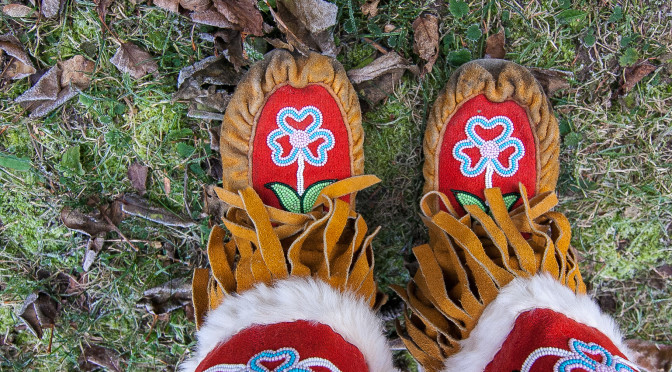Over 1,181 native women and girls in Canada have been reported missing or have been murdered in the last 30 years. Many vanished without a trace, with inadequate inquiry into their disappearance or murders paid by the media, the general public, politicians and even law enforcement. This is a travesty of justice. ~ Walking With Our Sisters website
************
Almost two thousand pairs of moccasin vamps, or uppers, lay evenly spaced, side by side and end to end, on the floor of the Carleton University Art Gallery, a breathtaking mosaic of traditional beadwork, sewing, painting, embroidery and other creative embellishment. A red fabric path, underlaid by cedar boughs, guides participants around and through the landscape of colour.
Each adult pair of vamps represents one missing or murdered Indigenous woman. More than one hundred smaller vamps – child-sized – are dedicated to the thousands who never came home from residential schools. These unfinished moccasins symbolize the lives cut short by violence and draw attention to the injustice, acknowledge the grief and torment of suffering families, invite community-based dialogue, and honour the memories of the lost women and children.
Metis artist Christi Belcourt describes Walking With Our Sisters as a “…memorial, commemoration, and ceremony.”
Everything follows traditional protocol. What we’re doing here is not an exhibit – although I might use that word… It’s ceremony from the very start to the very end of every display. That’s what’s required in order to properly acknowledge and honour the womens’ lives. We can’t do it by gawking, we can’t do it by seeing pictures, we can’t do this by staring from an outsider’s perspective. We must do it by bringing their lives – the acknowledgement of the value of their lives – within us, and within our hearts… ((https://www.youtube.com/watch?v=ehyOa05ecNA&feature=youtu.be))
************
Still, the blood flows.
Last week StatsCan released its first complete Aboriginal identity data on victims and people accused of homicide in Canada. 2014 marks the first year the survey has had complete police-reported data. As well, police-reported data on the Aboriginal identity of female homicide victims is now available from 1980 to 2013.
Out of 513 reported homicide victims in 2014, almost a quarter (23%) were reported by police as Aboriginal, a group that accounts for just 5% of the Canadian population.
The overrepresentation of Aboriginal people as homicide victims was greatest in Manitoba, where the rate was nine times higher than the rate for non-Aboriginal people (13.29 per 100,000 versus 1.41). This was followed by Nova Scotia, Ontario and Alberta, where the rates were six times higher, and Saskatchewan where the rate was five times higher. ((http://www.statcan.gc.ca/daily-quotidien/151125/dq151125a-eng.htm))
A single death, goes the quote, is a tragedy; a million deaths is a statistic.
These statistics are quantifiable, two-dimensional numbers on a page that fail to convey the three-dimensional people who no longer wake up in the morning, laugh with their children, engage with their elders, or wrap their arms around the people they love.
************
In June I attended the Truth & Reconciliation Commission of Canada (TRC) closing ceremonies in Ottawa. For three days I absorbed the speeches and testimony on the legacy of Canadian residential schools, my first significant exposure to the subject. I sat and I wandered, wondering if I belonged there, wrestling to accept that my duty – reinforced by the speakers – was to bear witness, a new idea to me. I walked the preview of Walking With Our Sisters and fell apart.
At least, then, I wasn’t surprised when I waited in line at the art gallery for the full installation, removing my shoes and preparing to smudge, that my chest began to heave, and the flood gates opened wide. Beautiful Barbara from Kitigan Zibi led me upstairs to the quiet room, offered tissues, tea and wise words, and sat close until I was ready to begin anew. She offered a final perspective: “While it is perfectly appropriate to feel sad,” she said, “it is important to recognize, and take away, the beauty of the work.”
While the beading and decorative work ranges from simple to complex, raw to sublime, each vamp carries its individual weight in the energetic expression of the whole. I wonder about the decisions made around placement: Do the pairs change position with each display or do they remain static in relation to one another? Unlike most art installations, there is no single section that shines brighter than another, a tribute to its careful curation. My son moves at his own speed, and I take my time, frequently doubling back, crouching to meditate on certain groups. It takes several journeys on the circular path to begin to fit the pieces together.
It is weeks before I grasp Barbara’s words. How brilliant to broach the horrors of violence through the antidote of beauty! Beauty enables reframing: powerful artist/creators breathe life into flat statistics, elevate them to personhood, and embed them into our active memory. Beauty restores dignity and human agency, moving away from the cult of victimhood, closing the gap between ‘us’ and ‘them.’ Beauty makes manifest the intangibles of knowledge, wisdom, strength, spirit and resiliency and revives the human heart. Poetic, too, that the medium enables us to walk, however briefly, in another person’s shoes.
************
Walking With Our Sisters opened in Edmonton in 2013 and is touring Canada and select U.S. cities through 2019. It is presently en route to North Battleford, Saskatchewan.
Additional information:
Walking With Our Sisters website
Truth and Reconciliation Commission of Canada: Calls to Action
National Inquiry into Missing and Murdered Aboriginal Women

2 responses to “Walking with Our Sisters”
Beautiful.
Thanks T.